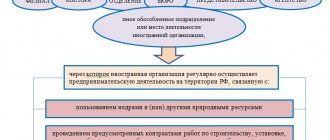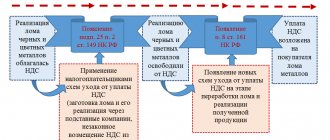KBK for payment of penalties on property tax for legal entities and organizations
| PENALIES, INTEREST, FINES | KBK | |
| Penalties, interest, fines on property tax of organizations not included in the Unified Gas Supply System | penalties | 182 1 06 02010 02 2100 110 |
| interest | 182 1 06 02010 02 2200 110 | |
| fines | 182 1 06 02010 02 3000 110 | |
| Penalties, interest, fines on property tax of organizations included in the Unified Gas Supply System | penalties | 182 1 06 02020 02 2100 110 |
| interest | 182 1 06 02020 02 2200 110 | |
| fines | 182 1 06 02020 02 3000 110 | |
For individuals
How to determine BCC for payment
The key question is: what is the Unified Gas Supply System, and whether the assets of the institution are included in this section.
Indeed, in order to choose the correct BCC property tax for 2022 for legal entities, you need to determine whether your property assets belong to the Unified State Gas System. The main regulatory document establishing general provisions on the Unified Gas Supply System is Federal Law No. 69-FZ dated March 31, 1999. Consequently, if your organization is guided in its activities by this standard, then, most likely, the property will be classified as part of the unified gas supply system.
For example, a simple general education school, kindergarten or non-profit organization providing personal services to the population must transfer property tax, KBK 2022 for legal entities - 182 1 0600 110. That is, the code for property objects not included in the Unified State Social System.
But the gas distribution station is already part of the UGSS. From assets of this category, the owner company will make payments to the budget under the BCC property tax in 2022 - 182 1 06 02020 02 1000 110.
The BCC of property tax for legal entities in 2022 is collected in the table:
| Name | Principal payment on obligations | KBK penalties for corporate property tax in 2022 | Interest on payment | Fines and penalties |
| Payments for property objects not included in the Unified Gas Supply System | 182 1 0600 110 | 182 1 0600 110 | 182 1 0600 110 | 182 1 0600 110 |
| Payments for property objects included in the Unified Gas Supply System | 182 1 0600 110 | 182 1 0600 110 | 182 1 0600 110 | 182 1 0600 110 |
KBK for payment of property tax for individuals
| TAX | KBK |
| Tax levied in cities of federal significance (Moscow, St. Petersburg, Sevastopol) | 182 1 06 01010 03 1000 110 |
| Tax levied within urban district boundaries | 182 1 06 01020 04 1000 110 |
| Tax levied within the boundaries of inter-settlement territories | 182 1 06 01030 05 1000 110 |
| Tax levied within settlement boundaries | 182 1 06 01030 10 1000 110 |
Results
For the property tax of organizations in 2022, three types of BCCs are provided: for the transfer of tax, payment of penalties and fines.
For individuals, there are 28 BCC values for property tax (for paying tax in cities, urban areas, within the boundaries of rural settlements, etc.). Tax authorities indicate the values of these BCCs in notifications for the payment of property taxes sent annually to individuals. You can find more complete information on the topic in ConsultantPlus. Free trial access to the system for 2 days.
KBK for payment of penalties on property tax for individuals
| PENALIES, INTEREST, FINES | KBK | |
| Penalties, interest, fines on taxes levied in cities of federal significance (Moscow, St. Petersburg, Sevastopol) | penalties | 182 1 06 01010 03 2100 110 |
| interest | 182 1 06 01010 03 2200 110 | |
| fines | 182 1 06 01010 03 3000 110 | |
| Penalties, interest, fines on taxes levied within the boundaries of urban districts | penalties | 182 1 06 01020 04 2100 110 |
| interest | 182 1 06 01020 04 2200 110 | |
| fines | 182 1 06 01020 04 3000 110 | |
| Penalties, interest, fines on taxes levied within the boundaries of inter-settlement territories | penalties | 182 1 06 01030 05 2100 110 |
| interest | 182 1 06 01030 05 2200 110 | |
| fines | 182 1 06 01030 05 3000 110 | |
| Penalties, interest, fines on taxes levied within the boundaries of settlements | penalties | 182 1 06 01030 10 2100 110 |
| interest | 182 1 06 01030 10 2200 110 | |
| fines | 182 1 06 01030 10 3000 110 | |
FILES
KBK-2022: corporate property tax
For any tax, there is a division of the BCC into several separate codes, each of which is designed to identify a specific payment.
Thus, the BCC for penalties or fines will be slightly different from the code accompanying the tax itself. The 2022 property tax code is no exception. It has the following gradation:
- BCC for corporate property tax - 182 1 0600 110;
- KBK penalties for property tax - 182 1 0600 110;
- BCC of fines for this tax is 182 1 0600 110.
These values were set for 2022 - 2022. They have been preserved in 2022 - the replacement of the regulatory legal acts regulating these codes did not affect them.
For a complete list of BCCs for the transfer of other taxes and contributions, see the Ready-made solution Consultant Plus. Study the material for free - get trial access to K+.
Innovations and features of calculus
Tax on the ownership of certain property is paid by individuals and organizations. This tax is calculated by the regulatory authority and sends a notification according to which the tax must be paid strictly within the specified period.
Innovations of 2016 for individuals
The Tax Code has introduced new rules for calculating property tax, effective from January 1, 2016: its cadastral value is taken as the tax base. That is, the more expensive the housing, the less profitable it will be for owners to own it, because they will have to pay a tax that differs tens of times from what they are used to.
Benefits were retained, but only for 1 of the properties of each type provided.
IMPORTANT! If your property contains objects that are subject to preferential taxation, and you did not indicate them in the declaration (you did not choose which of the objects will be the basis for the preferential tax rate), then the tax office will make a choice in favor of the highest for calculation.
Differences between KBK on property tax for legal entities and individuals
Property tax is paid by individuals and companies. For the first and second, the duty differs by type. So, for citizens this is a local tax, and for enterprises it is a regional one.
Individuals contribute tax funds depending on the location of the property: within the city (district), suburb, village, region. The tax on real estate of companies is paid depending on the location of the property on the territory of the Unified Gas Supply System.
The unified gas supply system is the territory on which the federal gas pipeline is located, transmitting natural gas throughout the country. Since the tax base is calculated from the cadastral value of the property, the location of the property also affects the price of the latter. Based on the price, the amount of the fee is calculated, and when paying the fee, organizations indicate this information. To make it easier for tax authorities to understand what contribution a company makes, the type of payment is encrypted under the appropriate BCC. Thus, the BCC for the property tax of individuals and enterprises differs according to the type of collection itself.
Rates and penalties for non-payment of property taxes
There are two separate chapters in the legislation regarding the levy on real estate for individuals and legal entities. The duty on property of citizens is regulated by Chapter 32 of Federal Law No. 117, and for companies - by Chapter 30 of Federal Law No. 117:
- Collection for companies. According to Art. 380 ch. 30 of the Tax Code of the Russian Federation, property tax for enterprises is calculated at the maximum rate - 2.2%. For individual regions, municipal authorities have the right to adjust the figure, but not more than the maximum amount. Also, benefits are provided for organizations up to a 0% rate. But the legislation of the Russian Federation warns that from January 1, 2035, the zero tariff will be eliminated and enterprises will pay the duty at the tariff established at that time.
- Collection for citizens. According to Art. 406 ch. 32 of the Tax Code of the Russian Federation, the amount of the duty is calculated based on the cadastral or inventory price of the property. In paragraph 4 of Art. 406, the collection rate varies from 0.1% for a price of up to 300,000 rubles to 2% for a price of more than 500,000 rubles. Just as for calculating duties for enterprises, municipal authorities have the right to establish differentiated tariffs for citizens, which depend on the cadastral price, the deflator coefficient in effect at the time of calculation, and the location of the taxable object.
For both types of payers, the reporting period is equal to a calendar year, and advance payments are made monthly. Missed payments and late payment of tax funds are punishable under one article for both entities for the payment of property taxes. According to Art. 122 Tax Code of the Russian Federation Federal Law No. 146 of July 31, 1998 (as amended on December 27, 2018), fine for:
- unintentional non-payment - 20% of the tax amount;
- intentional non-payment - 40% of the fee.
Gas pipeline tax for SNT
The gas pipeline is the property of a garden non-profit partnership (SNT), and the property, accordingly, is subject to taxation. Property taxation is regulated by Chapter 30 of the Tax Code of the Russian Federation, an explanation is provided by Letter of the Ministry of Finance of the Russian Federation dated 04/05/2012 No. 03-05-05-01/19.
The gardening non-profit partnership (in accordance with Article 373 of the Tax Code of the Russian Federation) is recognized as a taxpayer of the Russian Federation.
Tax legislation gives the constituent entities of the Russian Federation the right to independently establish:
- property tax rate for legal entities, but within 2.2%;
- tax benefits;
- tax payment deadlines.
When determining the tax rate, regional benefits, etc. it is necessary to refer to the regional regulations of specific municipalities. Article 375 and Article 376 of the Tax Code of the Russian Federation determines the tax base for calculating property tax. The tax base for calculating the tax on the SNT gas pipeline will be the average annual cost of the gas pipeline .
Considering the fact that SNT is a non-profit organization, when maintaining accounting records, determining the initial and residual cost of the gas pipeline, it is necessary to be guided by the Accounting Regulations “Accounting for Fixed Assets” PBU 6/01, approved by Order of the Ministry of Finance of Russia dated March 30, 2001 No. 26n.
The initial cost of the gas pipeline will be determined by all the costs that SNT incurred in organizing it:
- materials costs;
- expenses for construction and installation work;
- non-refundable tax payments;
- state duty, the payment of which is conditional on the acquisition of fixed assets;
- other costs associated with organizing a gas pipeline in SNT.
The following types of payments cannot be considered expenses:
- payment of VAT;
- payment of tax payments subject to reimbursement.
If, in accordance with clause 2 of Article 170 of the Tax Code of the Russian Federation, value added tax is not refundable, it will be taken into account when forming the initial cost of the object. The residual value of a gas pipeline is formed taking into account the wear and tear of gas pipeline equipment. When determining the residual value, you must be guided by clause 17 and clause 19 of the Accounting Regulations “Accounting for Fixed Assets” PBU 6/01. Read also the article: → “Accounting for fixed assets” (PBU 6/01).”
About the gas supply system and why it affects taxes
Order of the Ministry of Finance No. 132n dated 06/08/2018 on codes for the coming year provides for several property tax codes in 2022; codes are established for organizations, and its rates are determined by the constituent entities of the Russian Federation. However, they cannot be more than 2.2%. This is a general provision, and in Art. 380 of the Tax Code of the Russian Federation contains several exceptions to it.
In order to correctly transfer property tax, BCC 2022 for legal entities is included in the payment order. But in order to choose the right code, you need to understand what the Unified Gas Supply System (UGSS) is, since a separate code is established for payments for objects included in it.
The concept of unified gas supply is contained in Federal Law-69 of March 31, 1999; The law is part of the system of regulatory acts on gas supply in the Russian Federation. The term UGSS is disclosed in Art. 6 laws. This is a whole production complex of interconnected things, which represents the basis of gas supply in the Russian Federation. The accounting department or management of the organization should know about the classification of fixed assets of the organization as a unified gas supply system. In any case, if the company is guided in its activities by the specified federal law, then, most likely, the fixed assets belonging to it are classified as UGSS, and you need to select code 182 1 0600 110. If the organization is not related to the gasification of the country, for example, it is a grocery store or a hairdresser, or a kindergarten, you need to use KBK 182 1 0600 110.
Payment order for payment of property tax
General details
A payment order for the payment of property tax to the budget is generated using the Payment order in the Bank and cash desk section – Bank – Payment orders – Create button.
In this case, it is necessary to correctly indicate the type of transaction Tax payment , then the document form takes the form for payment of payments to the budget system of the Russian Federation.
You can also quickly generate a payment order using the Tax Payment Assistant :
- through the section Main – Tasks – List of tasks;
- through the section Bank and cash desk – Payment orders using the Pay button – Accrued taxes and contributions.
Please pay attention to filling out the fields:
- Tax – Organizational property tax , selected from the Taxes and Fees directory.
The property tax of organizations is predetermined in the Taxes and Contributions directory. The following parameters are specified for it:
- corresponding KBK code;
- text template inserted into the Payment purpose ;
- tax account.
If an element is predefined in the directory, then deleting it or changing its parameters is not recommended. If necessary, BukhExpert8 advises creating a new element in the Taxes and Contributions , to which you should specify your settings.
- Type of liability – Tax . The choice of the type of obligation affects the BCC, which will be indicated in the payment order;
- The order of payment is 5 Other payments (including taxes and contributions) , filled in automatically, as for all tax payments to the budget paid on time (clause 2 of Article 855 of the Civil Code of the Russian Federation).
Recipient details - Federal Tax Service
Since the recipient of the property tax is the tax office where the property tax declaration was submitted, it is its details that must be reflected in the Payment order document .
- The recipient - the Federal Tax Service, to which the tax is paid, is selected from the Counterparties directory;
- Recipient's account – bank details of the tax authority specified in the Recipient .
Currently, in the 1C program it is possible to use the 1C: Counterparty service, which allows you to automatically fill in and monitor the relevance of the details of government bodies.
If the details are no longer relevant, the 1C:Counteragent will offer to update them in the Counterparties directly from the payment order form. PDF
- Recipient's details - TIN , KPP and Recipient's name , these are the data that are used to print the payment order. If necessary, the recipient's details can be edited in the form that opens via the link.
Payment details to the budget
The accountant needs to control the data that the program fills in using the link Payment details to the budget .
In this form, you need to check that the fields are filled in:
- KBK - 18210602010021000110 “Property tax of an organization on property not included in the Unified Gas Supply System.” KBK is entered automatically from the Taxes and Contributions directory.
If the KBK is not known for any payment to the budget, then you can use the KBK Designer by following the link to the right of the KBK .
- OKTMO code is the code of the territory for which the tax is paid. The value is filled in automatically from the Organization directory ;
- Payer status – 01-taxpayer (payer of fees) – legal entity ;
- UIN - 0 , because The UIN can only be specified from the information in tax notices or requests for payment of tax (penalties, fines);
Individual entrepreneurs do not submit a property tax declaration to the Federal Tax Service; the tax for them is calculated by the Federal Tax Service. As a result, they make payments based on tax notices. When paying tax from an individual entrepreneur's current account, it is necessary to fill in the field in the Payment order details to the budget
- UIN – UIN indicated in the tax notice of tax payment.
- Basis of payment – TP payments of the current year ;
- Tax period – GD-annual payment , since in this case the property tax is paid for the tax period – a year;
- Year – 2017 , i.e. the year for which the tax is paid;
- Document number – 0 , because the document on the basis of which the payment is made is a declaration, and it does not have the requisite Number ;
- The document date is 03/30/2018 , i.e. date of signing of the declaration.
Find out more about the details of payments to the budget in the article Payment order details .
- Purpose of payment – filled in automatically using a template from the Taxes and Contributions directory. The field can be edited if necessary;
You can print a payment order by clicking the Payment order . PDF







